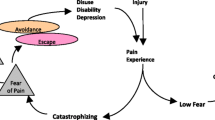Abstract
Recent research has indicated that the Pain Catastrophizing Scale (PCS) is a reliable measure that taps three dimensions of a singular construct. Gender differences have been found consistently in catastrophizing, with women reporting significantly higher scores than men on the PCS. This study was designed to cross-validate the factor structure of the PCS, independently for men and women, through second-order confirmatory factor analysis. Results indicate that the second-order models provide a good fit to the data. The conceptualization of catastrophizing as a singular latent construct, within a hierarchical factorial structure that consists of three first-order factors—rumination, magnification, and helplessness, was supported for both men and women. The second research objective was to test the two models for gender equivalence. Results indicate that all constraints held across gender. Together, these findings support the psychometric soundness of the PCS and indicate that the gender differences found are not due to an inadequate fit of the measurement or structural model.
Similar content being viewed by others
REFERENCES
Bentler, P. M., and Chou, C. P. (1987). Practical issues in structural modeling. Sociol. Methods Res. 16: 78–118.
Bentler, P. M., and Wu, E. J. C. (1993). EQS/Windows User's Guide: Version 4, BMDP Statistical Software, Los Angeles.
Byrne, B. M. (1994). Structural Equation Modeling With EQS and EQS/Windows: Basic Concepts, Applications and Programming, Sage, Thousand Oaks, CA.
Byrne, B. M., Baron, P., and Campbell, T. L. (1994). The Beck Depression Inventory (French Version): Testing for gender-invariant factorial structure for nonclinical adolescents. J. Adolesc. Res. 9(2): 166–179.
Chaves, J. F., and Brown, J. M. (1987). Spontaneous cognitive strategies for the control of clinical pain and stress. J. Behav. Med. 10: 263–276.
Dillon, W. R., Kumar, A., and Mulani, N. (1987). Offending estimates in covariance structure analysis: Comments on the causes of and solutions to heywood cases. Psychol. Bull. 101: 126–135.
Ellis, J. A., and D'Eon, J. L. (2002). Pain, emotion, and the situational specificity of catastrophising. Cognition & Emotion 16(4): 519–532.
Fillingim, R. B. (Ed.) (2000). Sex, Gender, and Pain: Progress in Pain Research and Management, IASP Press, Seattle, WA.
Keefe, F. J., Lefebvre, J. C., Egert, J. R., Affleck, G., Sullivan, M. J., and Caldwell, D. S. (2000). The relationship of gender to pain, pain behavior, and disability in osteoarthritis patients: The role of catastrophizing. Pain 87: 325–334.
Keogh, E., and Herdenfeldt, M. (2002). Gender, coping and the perception of pain. Pain 97: 195–201.
Osman, A., Barrios, F. X., Gutierrez, P. M., Kopper, B. A., Merrifield, T., and Grittmann, L.(2000). The pain catastrophizing scale: Further psychometric evaluation with adult samples. J. Behav. Med. 23: 351–365.
Osman, A., Barrios, F. X., Kopper, B. A., Hauptmann, W., Jones, J., and O'Neill, E. (1997). Factor structure, reliability, and validity of the pain catastrophizing scale. J. Behav. Med. 20: 589–605.
Riley, J. L., Robinson, M. E., Wise, E. A., Myers, C. D., and Fillingim, R. B. (1998). Sex differences in the perception of noxious experimental stimuli: A meta-analysis. Pain 74: 181–187.
Rosenstiel, A. K., and Keefe, F. J. (1983). The use of coping strategies in chronic low back pain patients: Relationship to patient characteristics and current adjustment. Pain 18: 33–44.
Severeijns, R., Vlaeyen, J. W. S., van den Hout, M. A., and Weber, W. E. J. (2001). Pain catastrophizing predicts pain intensity, disability, and psychological distress independent of the level of physical impairment. Clin.J.Pain 17: 165–172.
Spanos, N. P., Radtke-Bodorik, H. L., Ferguson, J. D., and Jones, B. (1979). The effects of hypnotic susceptibility, suggestions for analgesia, and utilization of cognitive strategies on the reduction of pain. J. Abnorm. Psychol. 88: 282–292.
Streiner, D. L., and Norman, G. R. (1995). Health Measure Scales: A Practical Guide to Their Development and Use, 2nd ed., Oxford University Press, New York.
Sullivan, M. J. L., Bishop, S. R., and Pivik, J. (1995). The Pain Catastrophizing Scale: Development and validation. Psychol. Assessm. 7: 524–532.
Sullivan, M. J. L., Stanish, W., Waite, H., Sullivan, M., and Tripp, D. A. (1998). Catastrophizing, pain, and disability in patients with soft-tissue injuries. Pain 77: 253–260.
Sullivan, M. J. L., Thorn, B., Haythornthwaite, J. A., Keefe, F., Martin, M., Bradley, L. A., and Lefebvre, J. C. (2001). Theoretical perspectives on the relation between catastrophizing and pain. Clin. J. Pain 17: 52–64.
Sullivan, M. J. L., Tripp, D. A., Rodgers, W. M., and Stanish, W. (2000a). Catastrophizing and ain perception in sport participants. J. Appl. Sport Psychol. 12: 151–167.
Sullivan, M. J. L., Tripp, D. A., and Santor, D. (2000b). Gender differences in pain and pain behaviour: The role of catastrophizing. Cogn. Ther. Res. 24: 121–134.
Turner, J. A., and Aaron, L. A. (2001). Pain-related catastrophizing: What is it? Clin.J.Pain 17: 65–71.
Turner, J. A., Jensen, M. P., Warms, C. A., and Cardenas, D. D. (2002). Catastrophizing is associated with pain intensity, psychological distress, and pain-related disability among individuals with chronic pain after spinal cord injury. Pain 98: 127–134.
Unruh, A. M. (1996). Gender variations in clinical pain experience. Pain 65: 123–167.
Van Damme, S., Crombez, G., Bijttebier, P., Goubert, L., and Van Houdenhove, B. (2002). A confirmatory factor analysis of the pain catastrophizing scale: Invariant factor structure across clinical and non-clinical populations. Pain 96: 319–324.
Author information
Authors and Affiliations
Rights and permissions
About this article
Cite this article
D'Eon, J.L., Harris, C.A. & Ellis, J.A. Testing Factorial Validity and Gender Invariance of the Pain Catastrophizing Scale. J Behav Med 27, 361–372 (2004). https://doi.org/10.1023/B:JOBM.0000042410.34535.64
Issue Date:
DOI: https://doi.org/10.1023/B:JOBM.0000042410.34535.64




